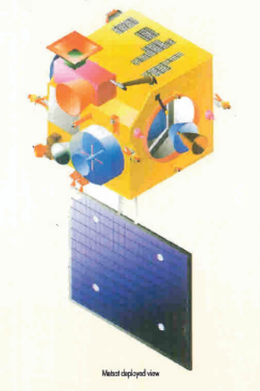 Kalpana-1 deployed Kalpana-1 deployed | |
| Mission type | Weather |
|---|---|
| Operator | ISRO |
| COSPAR ID | 2002-043A |
| SATCAT no. | 27525 |
| Website | Kalpana-1 on ISRO Web-site |
| Mission duration | Planned: 7 years Achieved: 15 years |
| Spacecraft properties | |
| Bus | I-1000 Bus |
| Manufacturer | ISRO Satellite Center Space Applications Centre |
| Launch mass | 1,060 kilograms (2,340 lb) |
| Dry mass | 498 kilograms (1,098 lb) |
| Power | 550 watts |
| Start of mission | |
| Launch date | 12 September 2002, 10:24:00 (2002-09-12UTC10:24Z) UTC |
| Rocket | PSLV-C4 |
| Launch site | SHAR, Satish Dhawan FLP |
| End of mission | |
| Deactivated | September 2017 |
| Orbital parameters | |
| Reference system | Geocentric |
| Regime | Geostationary |
| Longitude | 74° East |
| Eccentricity | 0.0 |
| Perigee altitude | 35,771 kilometres (22,227 mi) |
| Apogee altitude | 35,801 kilometres (22,246 mi) |
| Inclination | 0.48 degrees |
| Period | 1436.06 minutes |
| Epoch | 25 September 2002 |
| Instruments | |
| VHRR | |
Kalpana-1 was the first dedicated meteorological satellite launched by the Indian Space Research Organisation using Polar Satellite Launch Vehicle on 12 September 2002. The satellite is three-axis stabilized and is powered by solar panels, getting up to 550 watts (0.74 hp) of power. The METSAT bus was used as the basis for the Chandrayaan lunar orbiter mission of 2008.
History
Originally known as MetSat-1, the satellite was the first launched by the PSLV-C4 into the Geostationary orbit. On February 5, 2003, it was renamed to Kalpana-1 by the Indian Prime Minister Atal Bihari Vajpayee in memory of Kalpana Chawla—an Indian born NASA astronaut who perished in the Space Shuttle Columbia disaster.
The satellite features a Very High Resolution scanning Radiometer (VHRR), for three-band images (visible, infrared, and thermal infrared) with a resolution of 2 km × 2 km (1.2 mi × 1.2 mi), and a Data Relay Transponder (DRT) payload to provide data to weather terrestrial platforms. Its mission were to collect data in layer of clouds, water vapor, and temperature of the atmosphere and to establish a small satellite I-1000 bus system which can meet the exclusive service requirements of a meteorological payload for earth imageries
Kalpana-1 went out of service in mid-2018.
VHRR scanning radiometer
The three band images are:
- Visible
- Thermal infrared
- Water vapour infrared
See also
References
- "Kalpana - 1". www.isro.gov.in. ISRO. Archived from the original on 31 July 2017. Retrieved 31 October 2018.
- "ISAC_website". Indian Space Research Organization. Retrieved 18 January 2018.
- ^ "Geostationary Satellites - Kalpana-1(METSAT)". Indian Space Research Organization. 2009. Archived from the original (aspx) on 14 October 2009. Retrieved 20 October 2009.
- McDowell, Jonathan. "Satellite Catalog". Jonathan's Space Page. Retrieved 3 May 2018.
- "Kalpana-1". 12 July 2018.
- "Kalpana 1". Nssdc.gsfc.nasa.gov. NASA.
| ← 2001Orbital launches in 20022003 → | |
|---|---|
| January | |
| February | |
| March | |
| April | |
| May | |
| June | |
| July | |
| August | |
| September | |
| October | |
| November | |
| December | |
| Launches are separated by dots ( • ), payloads by commas ( , ), multiple names for the same satellite by slashes ( / ). Crewed flights are underlined. Launch failures are marked with the † sign. Payloads deployed from other spacecraft are (enclosed in parentheses). | |
This article about one or more spacecraft of India is a stub. You can help Misplaced Pages by expanding it. |
